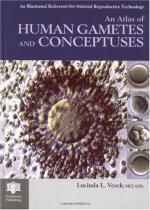|
This section contains 511 words (approx. 2 pages at 300 words per page) |

|
A gamete is a specialized reproductive cell. The cells usually have one half as many chromosomes in their nuclei as the majority of body cells, which are known as somatic cells. All sexually-reproducing plants, animals, and microbes produce gametes sometime during their life span.
During the second and third quarters of the nineteenth century the scientists J. L. Prevost, J. B. Dumas, T. Schwann, and R. Virchow were especially influential in the evolving consensus that sperm were cells, and that these cells united with other cells, ova or egg cells, to form a fertilized cell (a zygote) that went on to form a new organism.
Gametes usually form in the gonads, organs which form the sex cells. In flowering plants, the gonads are found in the flowers. The male gonads are the anthers, seen as the enlarged tips of the stamens. The anthers produce pollen (male gametes) in...
|
This section contains 511 words (approx. 2 pages at 300 words per page) |

|


